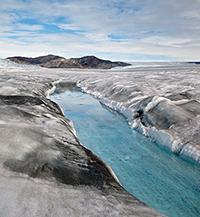Particle's Warming Impact Brought to Light: Measuring the impact of light-absorbing particles on Earth's snowpack, glaciers and ice cover
When dust, soot and other black or dark-colored particles emitted through pollution are deposited in snow and ice, they increase melting. Pacific Northwest National Laboratory led a comprehensive, state-of-the-science review of light-absorbing particles. Their findings offer a better understanding of these complex climate-changers, underscoring the particles' far-reaching influence, affecting freshwater supplies and sea-level rise, as well as atmospheric heat and cloud formation. The team summarized the range of methods used to measure these particles in snow and ice, especially in regions that are most sensitive to changes in the Earth's ability to reflect sunlight. The review also covered modeling progress and suggested ways to advance understanding the particles' impact on the global climate.
The team, led by Yun Qian at Pacific Northwest National Laborator, reviewed hundreds of research articles to summarize technical methods of measuring light-absorbing particles in snow and ice. They assessed the progress in measuring them in the Arctic, Tibetan Plateau, and other mid-latitude regions. The team also analyzedthe status of modeling the particles' mass concentrations, albedo reduction, radiative forcing, and climatic and hydrological impact at global and regional scales. Finally, they identified research needs for reducing uncertainties in the impact of light-absorbing particles in snowandice on global and regional climate and the hydrological cycle.
True to their name, light-absorbing particles attract sunlight and become a major factor in increasing snow and ice melt. They also influence Earth's temperature, the ability of the surface to reflect sunlight, the amount of freshwater, and the rise of sea levels. Thus, these particles were identified as formidable climate-changing agents in the fourth and fifth assessment reports of the Intergovernmental Panel on Climate Change. To understand how changes in biomass- and fuel-burning—a large source of these particles—might help mitigate glacier melting, scientists must disentangle the influences of the particles' natural and human-caused sources. The goal is to quantify the effects and simulate possible future changes to better understand changing climate.
In addition to heating the atmosphere by absorbing solar radiation and interacting with clouds, light-absorbing particles (LAP) deposited on snow reduce snow reflectance by darkening the surface, and accelerate snowmelt. LAP in snow were identified as one of the major forcing agents affecting climate change in the fourth and fifth assessment reports of Intergovernmental Panel on Climate Change. A team of scientists led by U.S. Department of Energy researchers at Pacific Northwest National Laboratory reviewed the status of scientific understanding and known uncertainties in how LAPs in snow/ice affect the cryosphere, climate, and hydrological cycle. The team summarized current technical methods and progress made in measuring the LAPs in snow/ice in the Arctic, Tibetan Plateau, and other mid-latitude regions. They also reported the progress made in modeling concentrations, albedo reduction, radiative forcing, and climatic and hydrological impact of LAPs in snow and ice at global and regional scales and concluded more coordinated measurements and modeling efforts should be done to advance the understanding of LAPs effect in snow/ice and quantify their impact on the cryosphere and global climate.
Sponsor: The Department of Energy's Office of Science, Biological and Environmental Research Program, as part of the Earth System Modeling Program.
Research Team: Yun Qian, Hailong Wang, Mo Wang and Rudong Zhang, PNNL; Teppei J. Yasunari, Goddard Earth Sciences Technology and Research and NASA Goddard Space Flight Center; Sarah J. Doherty and Stephen G. Warren, University of Washington; Mark G. Flanner, University of Michigan; William K. M. Lau, University of Maryland and NASA Goddard Space Flight Center; Ming Jing, China Meteorological Administration.

